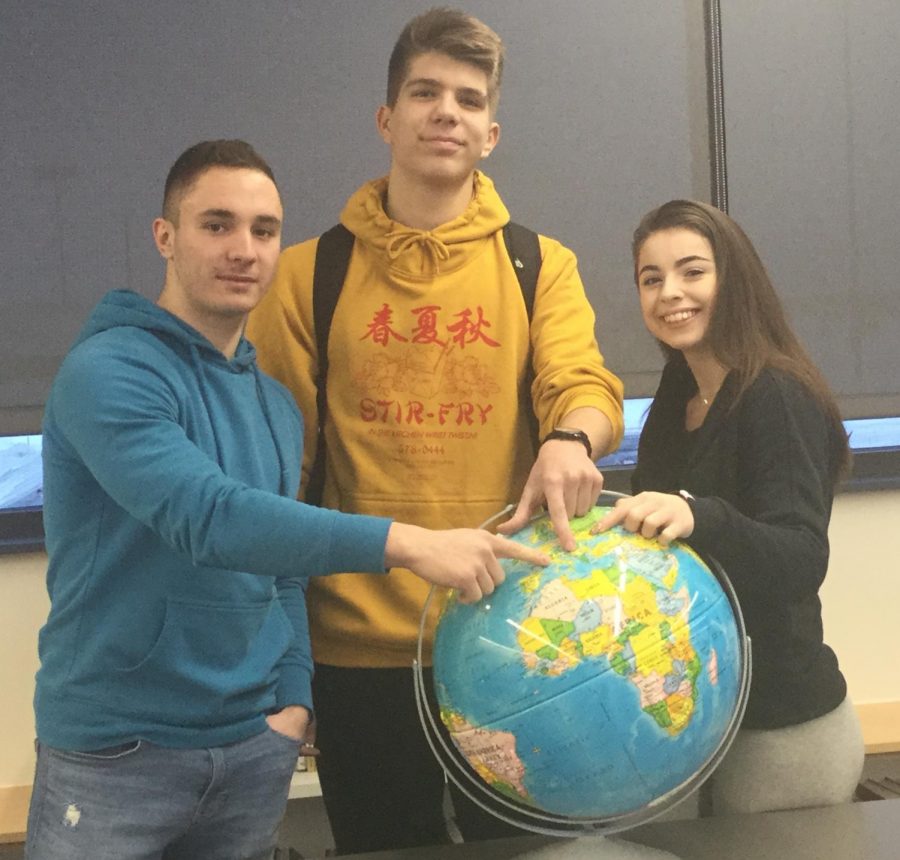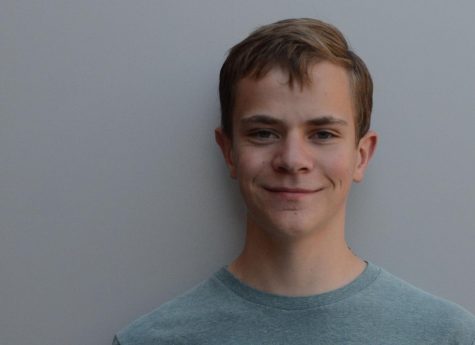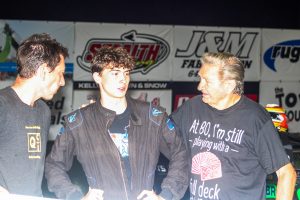The Foreign Exchange Experience
The three foreign exchange students at Johnston: Eduard Stancu from Italy, Aleksa Dogandzic from Serbia, and Anastasia Bilak from Ukraine.
February 13, 2019
Johnston, being landlocked in the middle of the United States, is not exactly a hub of diversity compared to many places like Chicago, London, or New York. Despite this, there are still three foreign exchange students attending the high school: Eduard Stancu ‘19, Anastasia Bilak ‘19, and Aleksa Dogandzic ‘19.
Stancu is from Trento, Italy, a city in the northeast part of the country near the Alps. He was originally connected to the foreign exchange organization that brought him here – CIEE – through a friend. Before he began to learn English, Stancu was already able to speak both Italian and Romanian fluently, as he was born in Romania and moved to Italy when he was five.
Stancu looks back on the move with somewhat indifferent thoughts. “It was kind of challenging, but it was not so bad because I had my family,” Stancu said. “I still have grandparents in Romania, so I usually go there once a year in the summer.”
He first connected with CIEE in August of last year, and knew where he was staying in March. CIEE assigns students locations based on where their host family lives. His host family chose to accept him, and because they live in Iowa, that is where he went.
To Stancu, the biggest difference between Italy and the U.S. is size. “Everything is bigger here. Everything – roads, cars and houses” Stancu said. He also said that in Italy, students might live very far away from the school – between 18 and 25 miles in some cases.
He also mentioned that sports are managed differently at the high school level. “One thing that surprised me [about the U.S.] is that [in Italy] we do not have high school teams for sports,” Stancu said. “So when I came here for the first time and they told me that I have practice every day with the school, it was something different for me because I play soccer in Italy, but I play with a club.”
The sudden language immersion was a challenge to Stancu for a while. “The language was quite different at first, but I tried to talk as much as possible to people to make friends,” Stancu said. “It is pretty weird because I am used to Italian…and I can speak Romanian too. I am learning English in the school, but it is still a very different thing to speak English every day.”
The language barrier made it hard for Stancu to reach out at first. “In the beginning, it was a little hard because I did not speak English very well,” Stance said. “At first, I was kind of afraid to start a conversation… Once I told people I was an exchange student, even if I did not speak English well, they still helped me and were very nice.”
The first friend Stancu met in the US was Dogandzic. They met in Advisory with Tim Brickley on the first day of school. Their Advisory is specifically set up for students new to Johnston. “Since we both joined the football team, he was one of the closest people I met here,” Stancu said.
Bilak is from Uzhhorod, Ukraine, near the borders of Slovakia and Hungary. She was given the opportunity to become a foreign exchange student through an organization called Flex. “It means I kind of won a scholarship,” Bilak said. “I paid nothing to be here… I just passed a few exams, and at the end I got a call; ‘Congratulations, you’re going to the U.S.’”. Flex is a US-based organization that is dedicated to giving students from certain former Eastern Bloc nations the opportunity to become foreign exchange students in the US.
When she got the news, she was very happy, but unsurprisingly she was also anxious about the trip and the experience in general. She got the call that she was going to the U.S. on April 6 of this year. That was all she knew, though, until July. She arrived in the U.S. on August 22 – three days before school started.
Her host family met her at the airport. She remembers looking for them at the airport. “I was going down the escalator, and seeing some balloons because I wasn’t the only foreign exchange student, and every family was waiting for their student. I was looking for my host family because I talked to them before, so I kind of knew what they looked like. I was looking for them for a while, and my friend saw her host family, and just ran to them. I was still looking for my family, then I saw their little girl with pink braids in her hair – that’s Carly – and Carly just ran to me. We both started crying, because I was so tired, and really nervous, meeting the people who you are going to live with for a year.”
Since meeting them at the airport, Bilak has gotten along very well with her host family. Bilak has a little sister, Sophia, back in Ukraine, and Carly reminds Bilak of her. “They are very much the same, but very different at the same time. I get along really good with Carly, and my host mom supports me with all of the problems I have.”
Bilak also says that the U.S. is very different from Ukraine. “Schools are different, people are different, and everything’s just so different, it’s hard to point a finger at what exactly makes it so different,” Bilak said. “We have eleven grades [in Ukraine]… we don’t have freshmen, sophomores, and seniors. We just have tenth grade, eleventh grade, eighth grade, etc,” Bilak said.
Of the foods Bilak and her family usually ate in Ukraine, she says that she misses traditional homemade soups most. Her favorite food to eat in the U.S. is orange chicken. “I don’t really know why, but it’s just so good,” Bilak said.
The language immersion is something Bilak dealt with here too. “It’s hard, it’s really hard, because sometimes you miss talking in your native language,” Bilak said. “You can’t just come up to someone and start talking to them in Ukrainian or Russian. When I was practicing English back in Ukraine, I talked to my friends in English to practice English, and after a few minutes, I could talk to them in Ukrainian. They’ll understand me. Here, I can’t because nobody will understand me.”
While mostly adjusted, Bilak has had some language slip-ups. She shared one particular occasion. “[Once] during seventh period, I had finished everything that I needed to finish, and I was texting my mom in Ukrainian,” Bilak said. “The teacher was talking to all of the students about a paper, and because I was thinking in Ukrainian, I asked him in Ukrainian, ‘What paper?’ Nobody heard that, but it was so embarrassing.”
Dogandzic is from the city of Užice, Serbia. Uzice is located in the western part of Serbia, near the Bosnian border. Like Bilak, Dogandzic also came to the US via Flex. He took tests fairly routinely from October to March, and got an email that he was accepted shortly after. “[When I got the news,] I was excited. I didn’t think I’d pass, because you can’t really prepare for it. Also, I’m younger than most kids. But, yeah, I never thought I’d go to Iowa.”
Dogandzic would be considered a junior in Serbia because he took his tests throughout his sophomore year and was accepted at the end of it, but because of the way Johnston chose to manage its foreign exchange students he is considered a senior here. While Dogandzic did not know the exact details of why that is, he speculated that it has to do with graduation. He got information regarding where he was going to and when he was leaving in late July.
When he arrived two days before school started, it was midday. ”My host mom and two kids picked me up at the airport. Then we came home… they showed me around, then my host dad came around and I met them all,” Dogandzic said. “We ate, and we talked for the rest of the night. The next day, we came here to get my schedule and stuff. I got my schedule, got a tour of the building, and emailed Coach Woodley about football… Those first few days were quite hectic, because you just came, and school started.”
In Serbia, English is taught beginning in first grade. “I wouldn’t say most Serbians can speak English… I’d compare it to Spanish here. A lot of people take Spanish here, but how many of them can actually speak Spanish?” Dogandzic said.
Dogandzic was better at speaking English than most Serbians even before he came to the US. Dogandzic attributes this to using English classes as a foundation and going beyond those classes on his own to learn more conversational English. “The biggest help was the Internet, YouTube, movies,” Dogandzic said. “School definitely… laid the foundation because you can’t just start watching it and understand it. You would probably start watching with subtitles because it just helps hearing it.”
His methods worked well enough for him to achieve a level of fluency before arriving in the US. “I guess you could say I was pretty fluent,” he said. “It wasn’t as much the understanding part, just getting used to it that everything is in English because the only time you encounter it in Serbia is maybe movie series, the Internet, and school. So coming here, and everything being in English… it was just weird.”
Despite having no knowledge of each other before this year, Bilak, Dogandzic and Stancu have all found friends in one another. Their backgrounds are different, but their stories share many of the same features. They have all adjusted to Iowa well, and are enjoying their stay. Despite being tossed in headfirst and having a challenge in the beginning, they have overcome their challenges and have come to enjoy it here.




